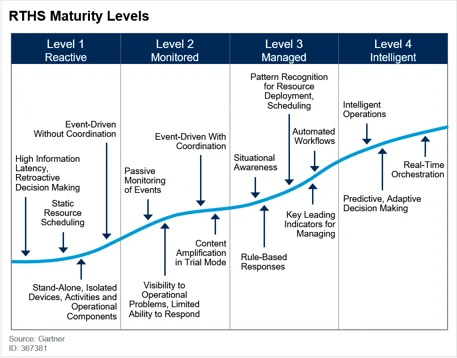RTLS INSIGHTS SUPPORT ALL PHASES OF YOUR REAL TIME HEALTH SYSTEM JOURNEY
The ability to react in the moment allows healthcare delivery organizations (HDOs) to maintain patient flow and optimize capacity management. Whether it’s a spike in wait times, delays in discharges, staff shortages, or equipment malfunction, each day brings new and often unexpected challenges. Real time location solutions (RTLS) are a fundamental building block to an HDO’s strategy toward a real time health system.
Gartner defines the real time health system as “an operational, management and technology paradigm for the next-generation HDO — one that acquires and acts on real-time operational intelligence to achieve its business objectives. The RTHS transforms the HDO from a disjointed and reactive enterprise to one that is more efficient, collaborative and predictive. The extent to which an HDO demonstrates the meaningful use of operational intelligence to adapt to changing circumstances surrounding the patient will, in large part, determine its RTHS maturity.”[1]

Insights to the location and condition of the equipment and people involved with healthcare delivery provide a foundation to respond to changing events in a coordinated way. Moreover, by selecting the right RTLS platform, HDOs are in a position to move up and to the right along Gartner’s RTHS Maturity Model.
RTLS Platform Sophistication Across the Maturity Model
As an HDO migrates from L1 to L4, the requirements of the RTLS platform increase. Basic functions like track and trace or patient counting is sufficient for L1. But to advance, you need the ability to drive coordination across the system – to bring the right people and equipment together to respond to a need. And further still, you need the ability to integrate with the hospital systems to elevate location information intelligently enterprise-wide. The RTLS platform that supports the HDO at L4 must integrate with EHR systems, inspect HL7 records in real time, trigger workflows for support tickets, maintenance & nurse call systems, react via natural voice commends, offer AI based insights & recommendations, facilitate real time communication with patients and staff, and more.
| L1 Reactive | L2 Monitored | L3 Managed | L4 Intelligent | |
| Asset Tracking | Find an asset | Par level accounting | Button push to trigger ServiceNow ticket | AI powered analytics to inform equipment distribution |
| Patient Flow | Count/locate patients | Monitor wait timesAlert patient to their turn | Transport request tied to wheelchair location | Coordinated discharge: porter, wheelchair, EVS |
| Bed Management | Locate beds | Provide the number of available beds | Button push marks bed as available via HL7 record | ChatGPT natural speech commands initiate workflows |
| Staff Safety | 1-way button push alert with location | 2-way tag comm for confirmation and coordination | Customized response rules, and escalation | Automated response with lights, door locks, displays, etc. |
| Hand Hygiene | Count washings | Confirmation to clinician of successful wash | Multi-protocol support by department or dispenser (soap vs. alcohol) | AI powered insights to trends & predictions |
RTLS Platform Requirements
When evaluating RTLS platforms and their ability to support your real time health system journey through level 4, there are hardware and software characteristics to look for.
Tag Versatility
- Buttons – software programmable to drive workflows
- LEDs & Message Display – interactions to coordinate workflows
- Wi-Fi 6, 5GHz – multi-band support for flexibility and future radio band options
- Motion sensing – alert to motion or lack of motion of people and equipment
- Temp & humidity – ambient temperature and optional probes for fridge units
- IP67 rating for durability and water resistance
Location Accuracy and Probability
- Track in the vertical dimension – shelf level accuracy in supply rooms
- Submeter accuracy – real time inventory & pinpointing equipment in the OR
- BLE HADM support for 20-30cm accuracy with simplified infrastructure
- 0.9 meter accuracy with 95% accuracy
Scalability
- Streaming communication for an IoT world
- Broker based software components for scalability – cloud or on premises
- AI friendly, machine learning friendly –
- Ability to run on mobile and embedded devices
Maintenance & Debug Tools
- Proactive monitoring of system health
- Live data capture from tags
- Debug session recording and upload to technical support
- Remote detection & placement of infrastructure
Integration
- Web, REST, and streaming APIs
- Low-code integration studio for speed & self sufficiency
- Containerization with major wireless vendors for ease of deployment & manageability
Breadth of Prepackaged Use Cases

- Asset Tracking
- Patient Flow
- Bed Management
- Staff Safety
- Hand Hygiene
- Wander Management
- Temperature Monitoring
We are happy to discuss how AiRISTA’s sofia RTLS platform can help you be more responsive and plot a strategy to advance along the maturity model for real time health systems. Please contact us at salesinfo@airista.com.
[1] Gartner, Put Patient Throughput and Capacity Management at the Center of Your Performance Improvement Plan, Barry Runyon, January 28, 2021





